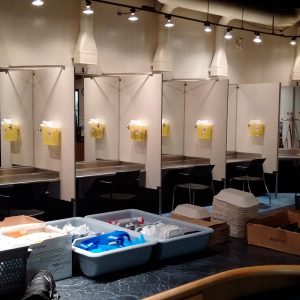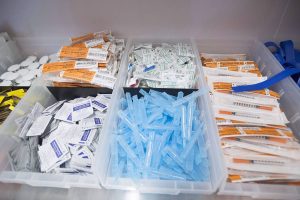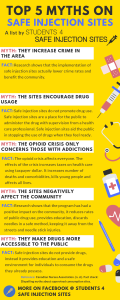by Sarah Erdlen
“It’s 5 o’clock somewhere.”
“Is it beer:thirty yet?”
“God, I could use a beer right now.”
Ever uttered one of these? Me, too. We’re all trying to cope with this world in whatever way we can. At the same time, it’s essential not to forget the context of alcohol, yes, even craft beer, as a drug. No matter how artisanal, no matter how meticulously crafted, or no matter how traditional, beer is still a substance we use to change our state of mind. So, why does alcohol escape the stigma of so many other drugs used for the same reason?
Alcohol isn’t the only substance with markedly different social acceptance than comparable options. We all take drugs all the time. We go to the drugstore on purpose to get them. Caffeine, aspirin, ibuprofen, and prescription medications are all drugs, as are cocaine, LSD, marijuana, heroin, and countless others. So how do we decide which drugs are legal and socially acceptable and which aren’t? (And don’t forget that legal doesn’t mean much about the supposed health of the substance. Legal opioids can be abused just like illegal ones. Tobacco is perfectly legal for adults and pretty terrible for you.)
As beer drinkers, we have particular insight into how understanding from our peers and safety measures supported by society can help us be prudent when we consume alcohol. We drink alcohol safely when we have friends looking out for us and rules about alcohol sales and consumption. Researchers and social justice advocates alike have seen how common-sense policies and compassion for those who use illegal drugs (or even those who abuse them) can reduce the amount of harm those drugs cause individuals and communities. We, craft beer drinkers, already have the soft skills of knowing what it feels like to need an external substance just to relax or just get through the day. Using that empathy to combat stigma, we can also enact practical strategies to ease punitive measures on people using substances and try to reverse the harm the war on drugs has caused. One of those strategies is supervised consumption.

The strategy of supervised consumption fits into a framework called harm reduction. Folks who advocate for harm reduction aim to treat people who use drugs with dignity through data-supported strategies that reduce death and disease in the community. Supervised consumption sites are places where people go to take drugs under the care of health professionals. Clients bring their own drugs, have a private place to use them, and a place to wait in while the drugs are in effect. Clean needles are available for those who need them, drastically reducing blood-borne pathogens, and used needles can be safely disposed of. Clients can be connected to social services and addiction treatment if interested. Starting from a supportive environment of care rather than punishment helps more folks seek treatment and helps those who do succeed.
Supervised consumption is a super familiar concept for craft beer drinkers. After all, that’s one of the primary functions of a bar. Supervised consumption means you go to a particular place, with specific professionals in charge, to imbibe. As beer drinkers, we head to a bar for many reasons. The unadorned fact remains that we are headed to a designated spot for a professional to dispense alcohol to us. Bartenders are in charge of making sure we don’t drink too much while there and that we aren’t already drunk when we walk in. (And they deserve much higher pay, along with benefits and safe working conditions, considering this high level of responsibility. Are the bartenders at your favorite bar given these things?) Bartenders are trained to spot inebriation and divert requests for another beer when someone seems over-served. As beer drinkers, we benefit routinely from supervised consumption sites that keep us safe directly and indirectly by monitoring the environment around us.
What’s the difference for other drugs? The most significant difference is that consumers need to bring their own substances with them to a supervised consumption site. The folks supervising at these sites are also a bit different: They’ve likely received lots of training in medical or counseling fields to spot medical issues, prevent or treat overdoses, and serve as a personal resource for consumers. Just like when drinking alcohol, supervised consumption sites allow consumers to engage with a substance in a safe environment. And all of us know how hard it can sometimes be to get through another day. Some of us use a beer to make it, and some of us use a different drug. To be able to do so in safety is a godsend.
By treating controlled substances as taboo, we cut off our ability to speak about them matter-of-factly and understand their effects. Just like understanding how factors like alcohol by volume (ABV), eating, hydration, and individual body characteristics can alter the effects of alcohol when we’re out for a few beers. As beer lovers, it’s essential to know how to recognize signs of intoxication and symptoms of alcohol poisoning. Only by understanding the bounds of safety can we relax and enjoy a few pints. If you never know what’s enough or don’t know how to recognize when you or someone else is over the limit, it’s tough to chill. The same can really be said for any type of recreational drug. Abstinence-only education isn’t helpful in any situation, and this one is no different. Accurate information about the effects and risks of drug use is essential not only for people who choose to use them but all of us, as we all live in the community with people who use drugs the same way we all live in the community with people who drink alcohol.
There are currently plenty of obstacles to allowing supervised consumption of products other than alcohol. As we’ve seen in the pursuit of legalizing marijuana, misinformation and stigma abound. There are plenty of arguments to be made around the regulation of alcohol and whether any particular law is helpful or not. However, regulating alcohol production and service, in general, contributes to safety in consumption. Again, knowing what you’re drinking, particularly in terms of ABV, means you can make choices for your own safety and pleasure. Regulation ensures that beers are appropriately labeled so you don’t get surprise drunk – possibly the worst kind of drunk. Regulation assures no substance in your beer you don’t know about. It’s not cut with or laced with anything you don’t want to be there. Regulation assures you won’t get sick from contaminated beer and that those responsible can be held accountable if you do. Similar rules, supported by real-world data, can be applied beyond alcohol.
Objections to supervised consumption that suppose there are no safe ways to consume illegal drugs tend to overlook the dangers of consuming legal ones. Is there a safe way to consume tobacco, with its well-documented and severe health risks? Maybe yes and maybe no, but that decision is primarily left to the consumer, while regulations are put in place for the marketing, sale, and precautions the tobacco industry can and must use. Is there a safe way to use fentanyl, arguably the most sensationalized substance of late? We already know the answer is yes, with appropriate boundaries, because health professionals administer fentanyl in safe doses, much like morphine or oxycodone, as part of regular medical treatment for pain. When we talk about drugs without the stigma and with an understanding of their historical, social, and medical contexts, we can make policies that reflect all of those realities rather than policies that reflect our fears.
And there are helpful middle steps we can take between current policies and supervised consumption sites in every city and town. We can decriminalize the practices that assist in safety, like needle exchanges. Currently, 16 states consider syringes to be “drug paraphernalia,” and thus, possession can be criminalized, without any exception for those using safe syringe exchange programs. Distributing clean needles is proven to prevent disease and death. We can allow folks to access safety-net programs like Supplemental Nutrition Assistance Program (or SNAP, formerly food stamps) even if they use drugs or have been incarcerated on drug charges. We can decriminalize the use or possession of drugs in steps, get rid of mandatory minimum sentencing, and make access to overdose-reversal medicines free of charge. Criminalization has not stamped out drug use nor served as a powerful deterrent. People who use drugs are humans like the rest of us and who among us hasn’t made a poor decision that we knew would hurt us? Whether continuing to drink when we already knew we were drunk or texting the ex who broke our heart, we’ve all been there. Treating people who use drugs with the human dignity they deserve means adjusting how society punishes their missteps more than any others.

Harm reduction strategies have already been successful in more than two dozen global countries. Countries that have decriminalized drugs – that is, reduced or completely eliminated any legal punishment for drug use – have seen marked drops in HIV infection rates and deaths from AIDS. Without the threat of fines or imprisonment, people who use drugs in these countries are more likely to seek medical and social services, including addiction treatment. And that’s precisely the point. This framework centers on public health rather than “law and order.” The war on drugs, with its harsh and uncompromising penalties for drug use, and its well-documented racial bias, has routinely disrupted community connectedness, one of the primary resources needed to reduce addiction.
Portugal is now more than 20 years into its decriminalization policy, which means there are troves of data available for countries that would like to follow suit. So far, the data has clearly shown that decriminalization reduces drug-related deaths and improves public health. From 1999 until 2007, the proportion of deaths in Portugal where opiates were the primary drug involved dropped from 95% to 55%. Twelve other countries across three continents have no sanctions for those possessing drugs for personal use. Fourteen more have significantly reduced penalties: Some simply confiscate the drugs and some levy fines. With this level of participation in harm reduction globally, it’s clear that these are not uncharted waters. There are many models to learn from and adapt to our own country to pursue safer and healthier communities across the US.
Supervised consumption has been a successful tool in the pursuit of public health. Beer drinkers already know that, even from a social standpoint. Most of us don’t just go to a bar to be watched. We go to chat with the bartender, meet our friends who are also drinking, see who is around, or maybe meet a neighbor or passing visitor. Bars are centers of community, where we build a social connections with close friends and passing acquaintances. Social connection is an essential component in treating addiction. So, whether your goal is to decrease the number of people using heroin, reduce the number of people facing severe illness from contaminated needles or drugs, or simply increase community connectedness, supervised consumption sites are a helpful tool. We can recognize the similarities between us all and put our community first.






